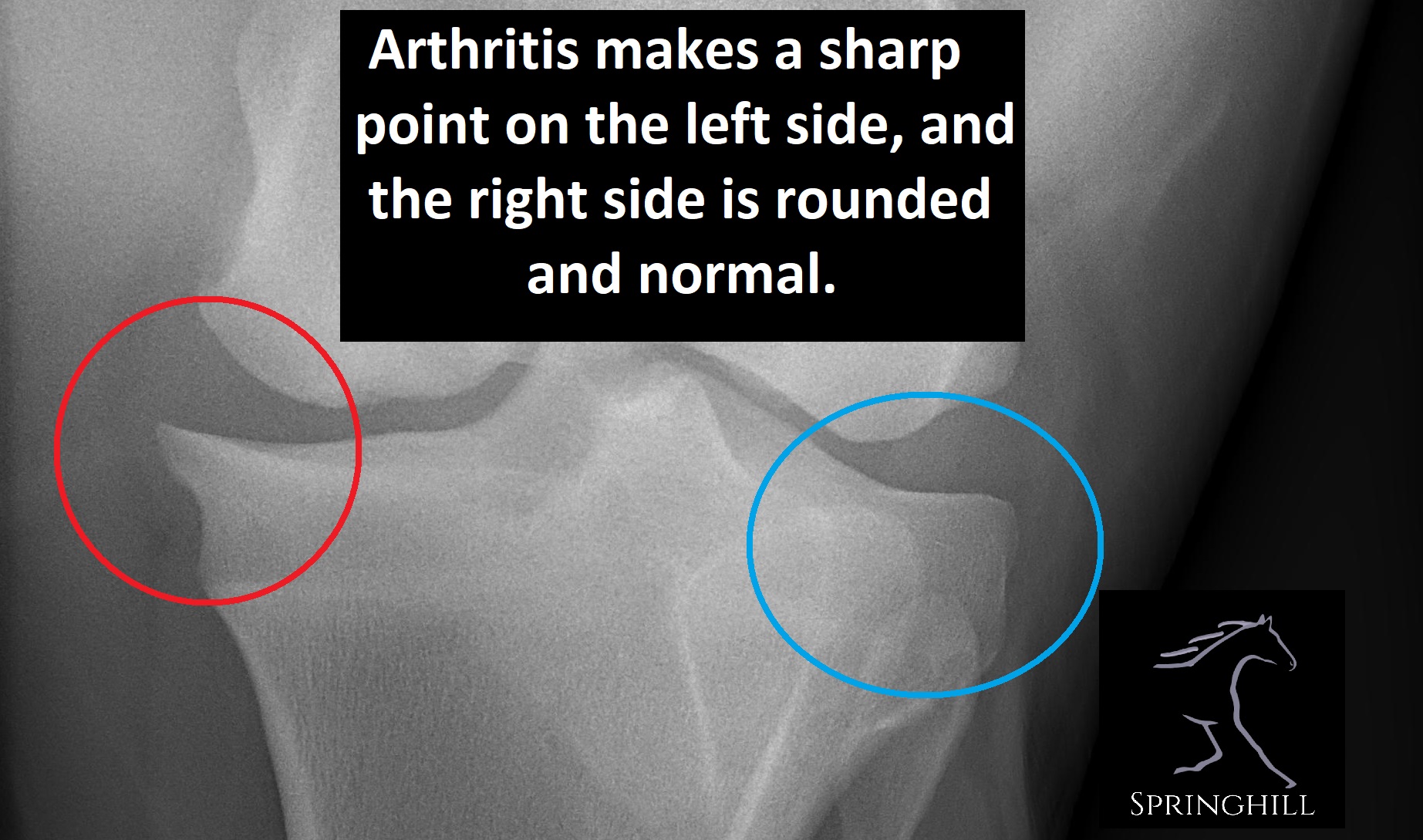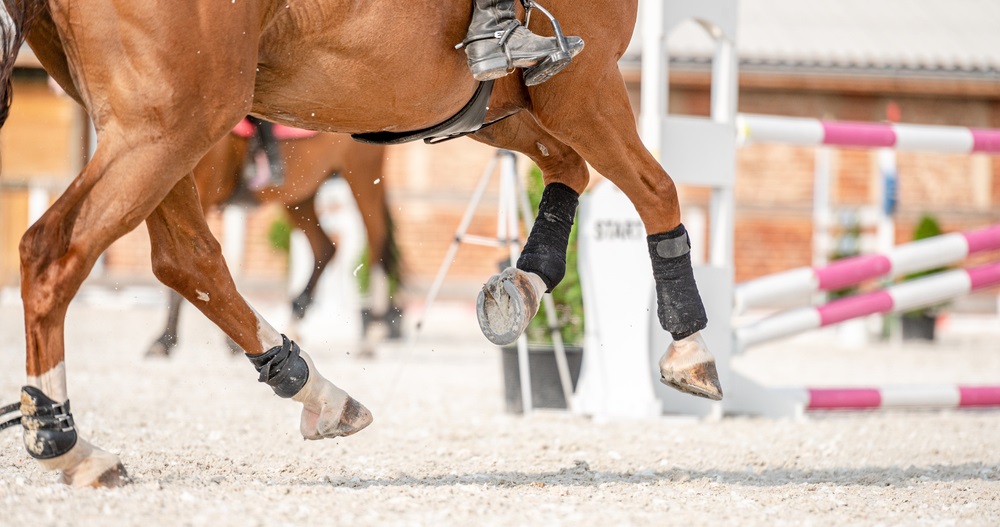Whinny’s Wisdoms

Hey everybody, Whinny here. As the Clinic Mouse and a brand-new blog-writer, I’ve been learning tons about what goes on at Springhill Equine! From my mouse-house on the side of the field, I can watch the Springhill vets evaluating horses as they trot up and down. Then If I scurry over by the clinic, I can hear what they talk about with the horses’ owners. One of the things that gets talked about a lot is arthritis. I’d never heard of that before, so one night I found this giant book someone left out and I read up on it. Wowzers, that was a looong chapter, and really complicated, so I couldn’t possibly tell you everything in it. I’m actually going to write two separate blogs on arthritis because there is so much stuff I thought was interesting! Today I’m going to go over what it is and what it does to your horse. In a few weeks, I’ll tell you what I learned about how to treat it!
What is Arthritis?
Well, first of all, a horse has joints. Hocks, stifles, pasterns, fetlocks – those are all joints. Mostly we think about the legs, but there are tons of joints in the neck and the back, too. The joints have to move constantly and also support the horse’s weight. That’s a hard job and they have to do it for the horse’s whole life!
A healthy joint has cartilage in it that provides a smooth surface over the bone for movement and shock absorption. There’s fluid in the joint, called synovial fluid, that lubricates the joint and helps to nourish the cartilage. That’s how it’s supposed to work.
Arthritis means inflammation in the joint and all the bad stuff it can cause. I’ll talk about why it happens in a minute, but basically, when you have arthritis, the cartilage becomes damaged and that causes pain, stiffness, and swelling of the joint. That results in lameness and all the ways it can affect your horse. Arthritis is usually progressive and results in permanent damage to the joint. If you’ve heard of degenerative joint disease, that’s another name for the same thing.

Arthritis is suuuper common. Lots of riding and show horses get it, but even wild horses do, too. I read that arthritis is responsible for up to 60% of all lameness. Considering how many lameness exams I see the Springhill vets doing, that’s a lot! I also read that 50% of horses older than 15 have some arthritis. So I’m glad I looked it up, since it must be really important.
How Does Arthritis Start?
There are a couple different types of arthritis. I’m going to talk about the most common kind, osteoarthritis (aka degenerative joint disease). There’s another kind called septic arthritis, caused by an infection in the joint, but that’s different so I’ll save it for another blog. Osteoarthritis is most often caused by “wear-and-tear” of the cartilage over time. It starts with low-level inflammation in the joint caused by exercise or aging. The inflammation can overwhelm the body’s ability to contain it, and a vicious cycle begins. Destructive enzymes are produced in the joint, breaking down the lubricating synovial fluid and causing it to become thinner and less protective. The cartilage molecules (proteoglycans and collages) are damaged and lose integrity.
Because of that, the cartilage’s ability to retain water and provide shock absorption is decreased. The damage stimulates even more inflammation, more destructive enzymes, and more cartilage damage, and so the cycle continues. If left untreated, the inflammation will lead to long-term deterioration of the joint. Eventually, the cartilage can erode away entirely, leaving exposed bone without its protective cartilage cap. This is very painful, advanced arthritis.
Osteoarthritis can also be caused by a sudden, direct injury to the cartilage or bone such as a chip fracture in the joint, a developmental joint disease like an OCD lesion (see Tony’s previous blog on OCD), or instability of the tissues that support the joint. Those things will jump-start the progression of arthritis, but it ends up the same as the wear-and-tear type, with permanent degradation of the joint cartilage.
What Does Arthritis Look Like?
So if your horse has arthritis, how will you know? One important thing I learned is that you won’t always see obvious limping. While there definitely can be clear lameness, especially if the arthritis is already severe, there are also more subtle signs that your horse may have a painful joint. He may just feel stiff with a shortened stride. A horse with arthritis sometimes warms up out of his stiffness after riding for a little while, or the stride may stay short and choppy the whole time. He might have trouble picking up or keeping a canter lead, or he might cross-canter with the front end on one lead and the hind end on the other. He might lack power while jumping or have difficulty stopping or turning.
You may notice that a horse with arthritis in his hind end drags his toes and wears the toe of his hind hooves or shoes excessively. Your farrier may tell you that your horse has trouble holding up a leg for hoof trims. Horses with more advanced arthritis may have an obviously enlarged joint, difficulty getting up after laying down, or not move around the pasture as much. Sometimes chronic soreness can cause a horse to become sour or look like he has a bad attitude. It’s not his fault though, he just hurts. Hopefully you guys understand that a lot of the time, horses aren’t just being naughty, and if you can treat the pain, he’ll be a lot happier to keep working.

Diagnosing Arthritis
Remember that vicious cycle of inflammation I told you about? It’s super important to get it under control so you can slow the progression of arthritis as much as possible. The key is to catch it early, since the longer you wait, the more damage will occur. Have one of my Springhill vets check out your horse for even mild stiffness or a change in behavior under saddle.
She’ll begin by talking with you about what you’ve noticed in your horse. Then, she’ll do a physical exam to feel for swelling and other joint abnormalities. She’ll watch your horse move and may flex his joints to help identify which area is bothering him. Depending on what she finds, she may need to perform “diagnostic analgesia” – temporary numbing of a joint to determine whether it’s the source of pain. Then, she may recommend an x-ray to look at what’s happening to the bone inside the joint.
X-rays are the most common type of imaging used to diagnose arthritis since they can be done either at your farm or here at the clinic. Occasionally, other types of imaging are needed, such as nuclear scintigraphy or arthroscopic surgery, but those cases aren’t very common. Getting an accurate diagnosis is the best way to manage your horse’s comfort.
Once the diagnosis is made, it’s time to make a treatment plan. But there are more options nowadays than there used to be, so I’m going to save that for my next blog on treating arthritis!
That’s it for this week!
~Whinny
P.S. If you want to really get to expert status on this, and you can’t wait for Part 2 of this blog, go check out our Podcast Episode on Equine Arthritis. You can listen to it right from that link, or from the Podcast Page on my website, or from whatever podcast app you use, like Spotify, Apple Podcasts, and all those. If you’re searching for it, the name of the show is Straight from the Horse Doctor’s Mouth. Listening to that is the fastest way to become a horse health guru! Well, in combination with reading my blog, of course.
 Whinny’s Wisdoms is the official blog of Whinny the Clinic Mouse at Springhill Equine Veterinary Clinic in Newberry, Florida. If you liked this blog, please subscribe below, and share it with your friends on social media! For more information, please call us at (352) 472-1620, visit our website at SpringhillEquine.com, or follow us on Facebook!
Whinny’s Wisdoms is the official blog of Whinny the Clinic Mouse at Springhill Equine Veterinary Clinic in Newberry, Florida. If you liked this blog, please subscribe below, and share it with your friends on social media! For more information, please call us at (352) 472-1620, visit our website at SpringhillEquine.com, or follow us on Facebook!
[jetpack_subscription_form title="Subscribe to Whinny's Wisdoms"]

